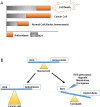Glutathione metabolism in cancer progression and treatment resistance
- PMID: 29915025
- PMCID: PMC6028537
- DOI: 10.1083/jcb.201804161
Glutathione metabolism in cancer progression and treatment resistance
Abstract
Glutathione (GSH) is the most abundant antioxidant found in living organisms and has multiple functions, most of which maintain cellular redox homeostasis. GSH preserves sufficient levels of cysteine and detoxifies xenobiotics while also conferring therapeutic resistance to cancer cells. However, GSH metabolism plays both beneficial and pathogenic roles in a variety of malignancies. It is crucial to the removal and detoxification of carcinogens, and alterations in this pathway can have a profound effect on cell survival. Excess GSH promotes tumor progression, where elevated levels correlate with increased metastasis. In this review, we discuss recent studies that focus on deciphering the role of GSH in tumor initiation and progression as well as mechanisms underlying how GSH imparts treatment resistance to growing cancers. Targeting GSH synthesis/utilization therefore represents a potential means of rendering tumor cells more susceptible to different treatment options such as chemotherapy and radiotherapy.
© 2018 Bansal and Simon.
Figures



References
-
- Anderton B., Camarda R., Balakrishnan S., Balakrishnan A., Kohnz R.A., Lim L., Evason K.J., Momcilovic O., Kruttwig K., Huang Q., et al. . 2017. MYC-driven inhibition of the glutamate-cysteine ligase promotes glutathione depletion in liver cancer. EMBO Rep. 18:569–585. 10.15252/embr.201643068 - DOI - PMC - PubMed
-
- Andringa K.K., Coleman M.C., Aykin-Burns N., Hitchler M.J., Walsh S.A., Domann F.E., and Spitz D.R.. 2006. Inhibition of glutamate cysteine ligase activity sensitizes human breast cancer cells to the toxicity of 2-deoxy-D-glucose. Cancer Res. 66:1605–1610. 10.1158/0008-5472.CAN-05-3462 - DOI - PubMed
Publication types
MeSH terms
Substances
Grants and funding
LinkOut - more resources
Full Text Sources
Other Literature Sources
Medical

